Commercial Project Negotiation: Outcomes and Analysis Report
VerifiedAdded on 2021/06/16
|8
|1725
|106
Report
AI Summary
This report provides a comprehensive analysis of commercial project negotiation, focusing on the differences between government and non-government contracts. It explores key aspects such as contractual arrangements, stakeholder engagement, project negotiation methods, stakeholder relationships, consequences of delays and disruptions, and the use of project management tools. The report uses case studies, including the Channel Tunnel Project and the Queensland Health Payroll System Project, to illustrate the concepts discussed. It highlights the significance of negotiation strategies, communication, and conflict management in achieving successful project outcomes. The report concludes with a discussion on the importance of project management tools and the impact of delays and disruptions, emphasizing the need for effective strategies to mitigate conflicts and ensure project success. The report also covers the differences in project management approaches and their impact on stakeholder relationships and project outcomes.
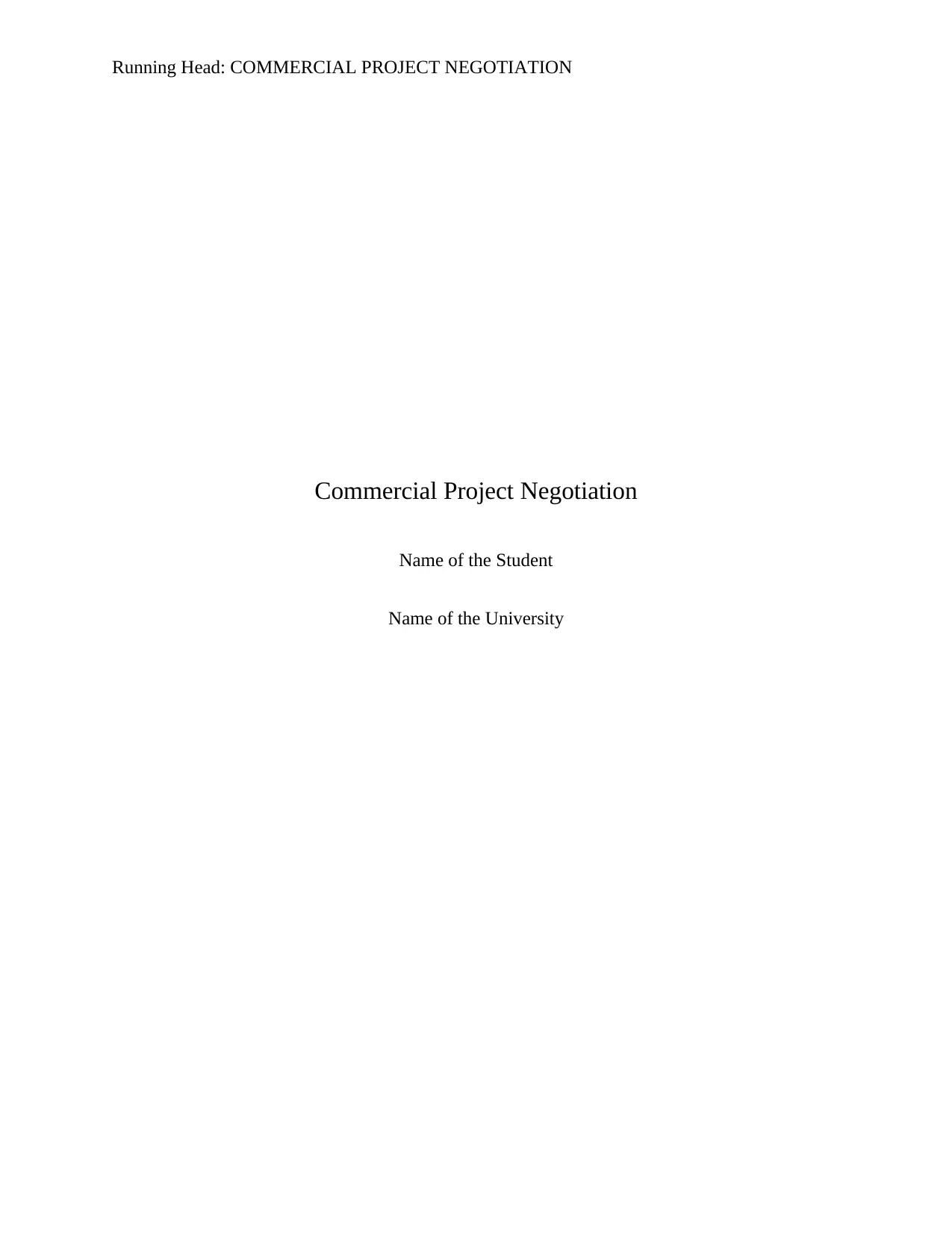
Running Head: COMMERCIAL PROJECT NEGOTIATION
Commercial Project Negotiation
Name of the Student
Name of the University
Commercial Project Negotiation
Name of the Student
Name of the University
Paraphrase This Document
Need a fresh take? Get an instant paraphrase of this document with our AI Paraphraser
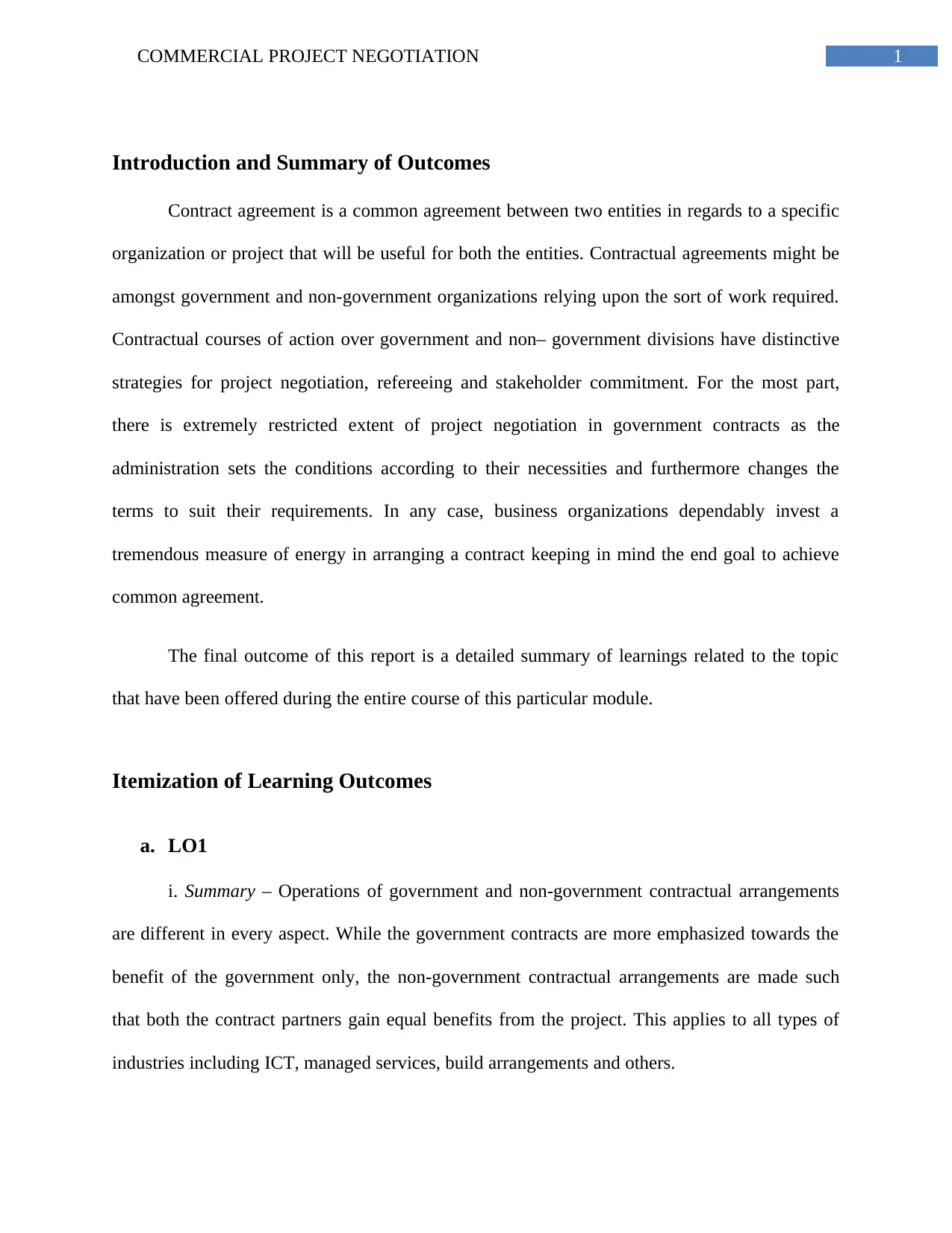
1COMMERCIAL PROJECT NEGOTIATION
Introduction and Summary of Outcomes
Contract agreement is a common agreement between two entities in regards to a specific
organization or project that will be useful for both the entities. Contractual agreements might be
amongst government and non-government organizations relying upon the sort of work required.
Contractual courses of action over government and non– government divisions have distinctive
strategies for project negotiation, refereeing and stakeholder commitment. For the most part,
there is extremely restricted extent of project negotiation in government contracts as the
administration sets the conditions according to their necessities and furthermore changes the
terms to suit their requirements. In any case, business organizations dependably invest a
tremendous measure of energy in arranging a contract keeping in mind the end goal to achieve
common agreement.
The final outcome of this report is a detailed summary of learnings related to the topic
that have been offered during the entire course of this particular module.
Itemization of Learning Outcomes
a. LO1
i. Summary – Operations of government and non-government contractual arrangements
are different in every aspect. While the government contracts are more emphasized towards the
benefit of the government only, the non-government contractual arrangements are made such
that both the contract partners gain equal benefits from the project. This applies to all types of
industries including ICT, managed services, build arrangements and others.
Introduction and Summary of Outcomes
Contract agreement is a common agreement between two entities in regards to a specific
organization or project that will be useful for both the entities. Contractual agreements might be
amongst government and non-government organizations relying upon the sort of work required.
Contractual courses of action over government and non– government divisions have distinctive
strategies for project negotiation, refereeing and stakeholder commitment. For the most part,
there is extremely restricted extent of project negotiation in government contracts as the
administration sets the conditions according to their necessities and furthermore changes the
terms to suit their requirements. In any case, business organizations dependably invest a
tremendous measure of energy in arranging a contract keeping in mind the end goal to achieve
common agreement.
The final outcome of this report is a detailed summary of learnings related to the topic
that have been offered during the entire course of this particular module.
Itemization of Learning Outcomes
a. LO1
i. Summary – Operations of government and non-government contractual arrangements
are different in every aspect. While the government contracts are more emphasized towards the
benefit of the government only, the non-government contractual arrangements are made such
that both the contract partners gain equal benefits from the project. This applies to all types of
industries including ICT, managed services, build arrangements and others.
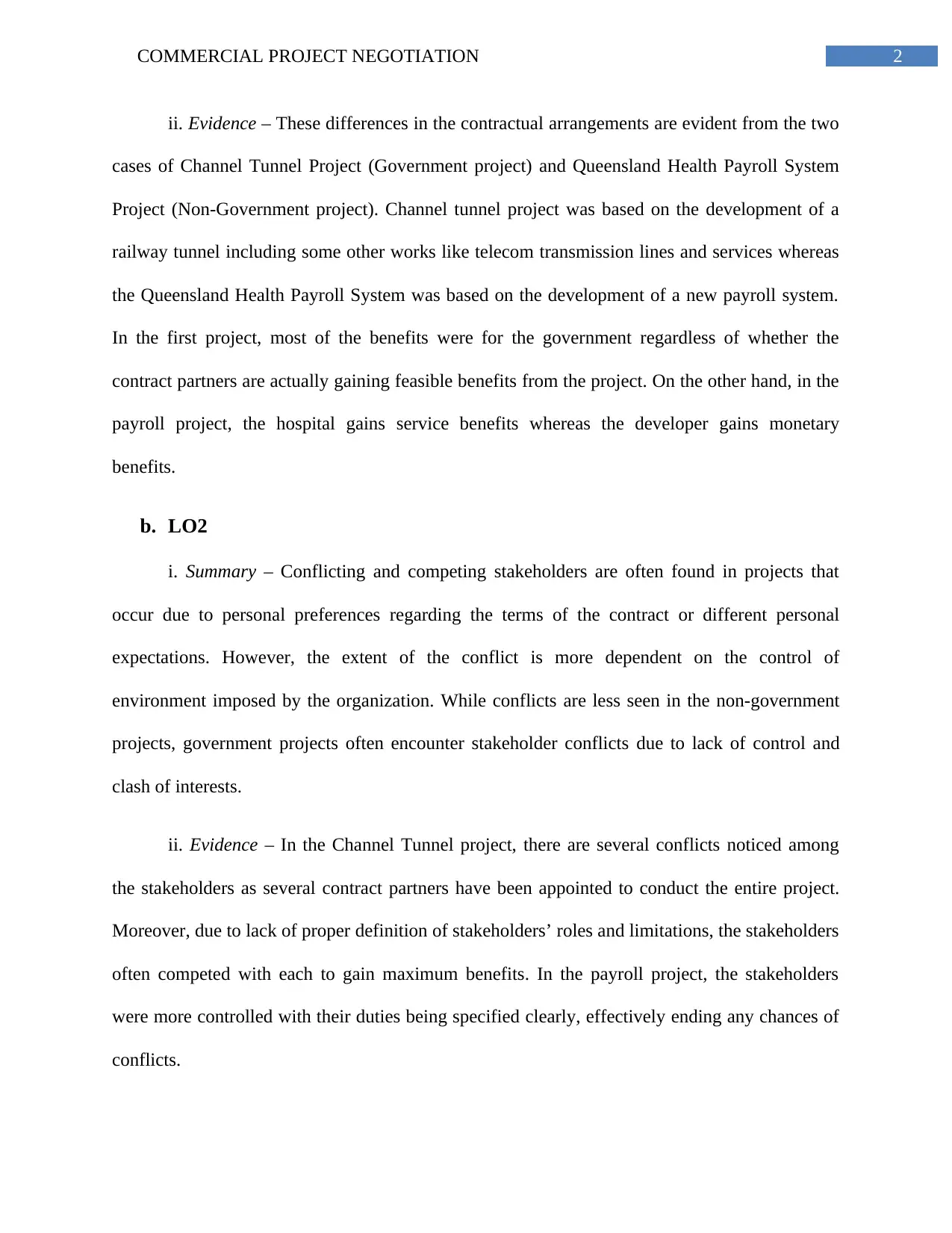
2COMMERCIAL PROJECT NEGOTIATION
ii. Evidence – These differences in the contractual arrangements are evident from the two
cases of Channel Tunnel Project (Government project) and Queensland Health Payroll System
Project (Non-Government project). Channel tunnel project was based on the development of a
railway tunnel including some other works like telecom transmission lines and services whereas
the Queensland Health Payroll System was based on the development of a new payroll system.
In the first project, most of the benefits were for the government regardless of whether the
contract partners are actually gaining feasible benefits from the project. On the other hand, in the
payroll project, the hospital gains service benefits whereas the developer gains monetary
benefits.
b. LO2
i. Summary – Conflicting and competing stakeholders are often found in projects that
occur due to personal preferences regarding the terms of the contract or different personal
expectations. However, the extent of the conflict is more dependent on the control of
environment imposed by the organization. While conflicts are less seen in the non-government
projects, government projects often encounter stakeholder conflicts due to lack of control and
clash of interests.
ii. Evidence – In the Channel Tunnel project, there are several conflicts noticed among
the stakeholders as several contract partners have been appointed to conduct the entire project.
Moreover, due to lack of proper definition of stakeholders’ roles and limitations, the stakeholders
often competed with each to gain maximum benefits. In the payroll project, the stakeholders
were more controlled with their duties being specified clearly, effectively ending any chances of
conflicts.
ii. Evidence – These differences in the contractual arrangements are evident from the two
cases of Channel Tunnel Project (Government project) and Queensland Health Payroll System
Project (Non-Government project). Channel tunnel project was based on the development of a
railway tunnel including some other works like telecom transmission lines and services whereas
the Queensland Health Payroll System was based on the development of a new payroll system.
In the first project, most of the benefits were for the government regardless of whether the
contract partners are actually gaining feasible benefits from the project. On the other hand, in the
payroll project, the hospital gains service benefits whereas the developer gains monetary
benefits.
b. LO2
i. Summary – Conflicting and competing stakeholders are often found in projects that
occur due to personal preferences regarding the terms of the contract or different personal
expectations. However, the extent of the conflict is more dependent on the control of
environment imposed by the organization. While conflicts are less seen in the non-government
projects, government projects often encounter stakeholder conflicts due to lack of control and
clash of interests.
ii. Evidence – In the Channel Tunnel project, there are several conflicts noticed among
the stakeholders as several contract partners have been appointed to conduct the entire project.
Moreover, due to lack of proper definition of stakeholders’ roles and limitations, the stakeholders
often competed with each to gain maximum benefits. In the payroll project, the stakeholders
were more controlled with their duties being specified clearly, effectively ending any chances of
conflicts.
⊘ This is a preview!⊘
Do you want full access?
Subscribe today to unlock all pages.

Trusted by 1+ million students worldwide
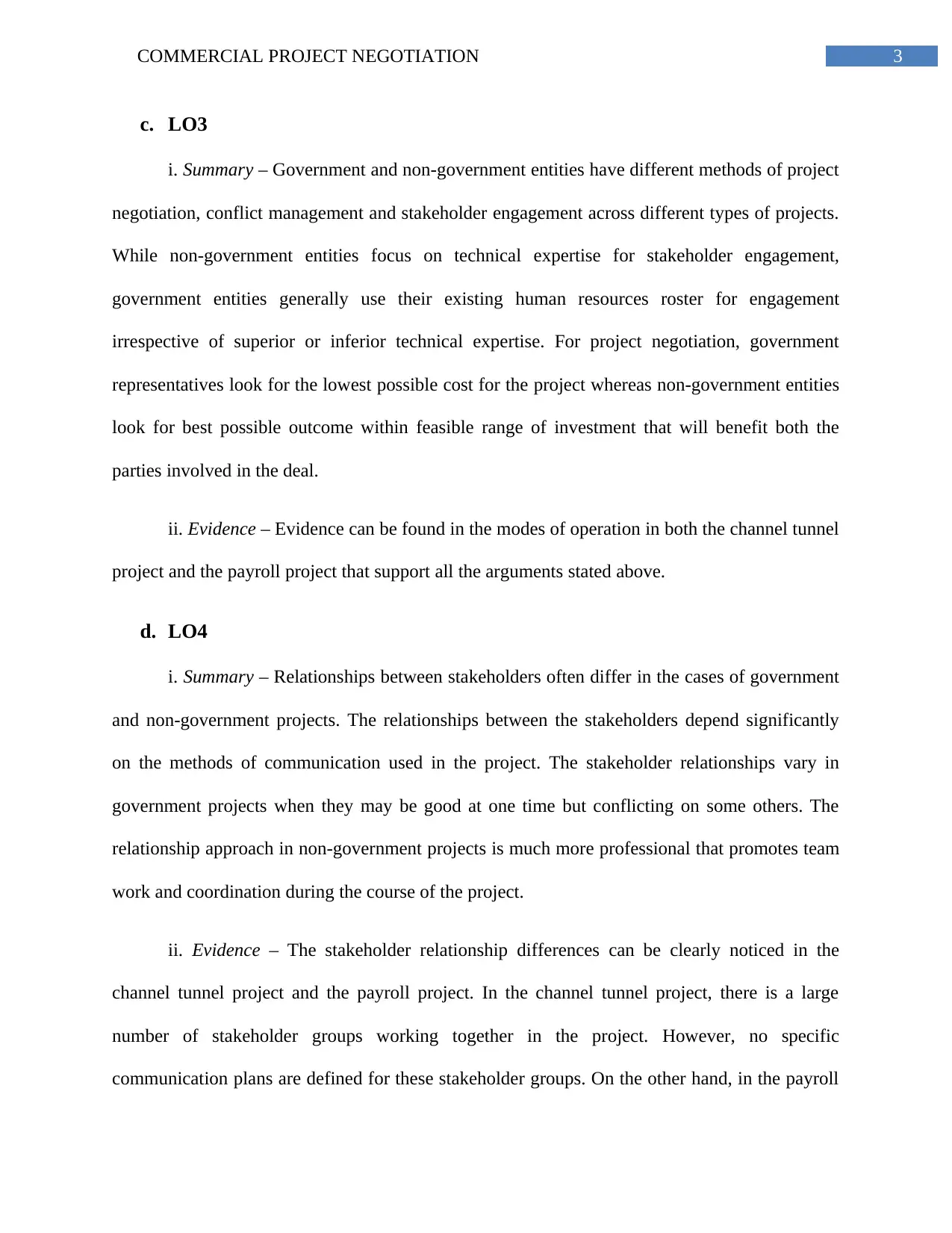
3COMMERCIAL PROJECT NEGOTIATION
c. LO3
i. Summary – Government and non-government entities have different methods of project
negotiation, conflict management and stakeholder engagement across different types of projects.
While non-government entities focus on technical expertise for stakeholder engagement,
government entities generally use their existing human resources roster for engagement
irrespective of superior or inferior technical expertise. For project negotiation, government
representatives look for the lowest possible cost for the project whereas non-government entities
look for best possible outcome within feasible range of investment that will benefit both the
parties involved in the deal.
ii. Evidence – Evidence can be found in the modes of operation in both the channel tunnel
project and the payroll project that support all the arguments stated above.
d. LO4
i. Summary – Relationships between stakeholders often differ in the cases of government
and non-government projects. The relationships between the stakeholders depend significantly
on the methods of communication used in the project. The stakeholder relationships vary in
government projects when they may be good at one time but conflicting on some others. The
relationship approach in non-government projects is much more professional that promotes team
work and coordination during the course of the project.
ii. Evidence – The stakeholder relationship differences can be clearly noticed in the
channel tunnel project and the payroll project. In the channel tunnel project, there is a large
number of stakeholder groups working together in the project. However, no specific
communication plans are defined for these stakeholder groups. On the other hand, in the payroll
c. LO3
i. Summary – Government and non-government entities have different methods of project
negotiation, conflict management and stakeholder engagement across different types of projects.
While non-government entities focus on technical expertise for stakeholder engagement,
government entities generally use their existing human resources roster for engagement
irrespective of superior or inferior technical expertise. For project negotiation, government
representatives look for the lowest possible cost for the project whereas non-government entities
look for best possible outcome within feasible range of investment that will benefit both the
parties involved in the deal.
ii. Evidence – Evidence can be found in the modes of operation in both the channel tunnel
project and the payroll project that support all the arguments stated above.
d. LO4
i. Summary – Relationships between stakeholders often differ in the cases of government
and non-government projects. The relationships between the stakeholders depend significantly
on the methods of communication used in the project. The stakeholder relationships vary in
government projects when they may be good at one time but conflicting on some others. The
relationship approach in non-government projects is much more professional that promotes team
work and coordination during the course of the project.
ii. Evidence – The stakeholder relationship differences can be clearly noticed in the
channel tunnel project and the payroll project. In the channel tunnel project, there is a large
number of stakeholder groups working together in the project. However, no specific
communication plans are defined for these stakeholder groups. On the other hand, in the payroll
Paraphrase This Document
Need a fresh take? Get an instant paraphrase of this document with our AI Paraphraser
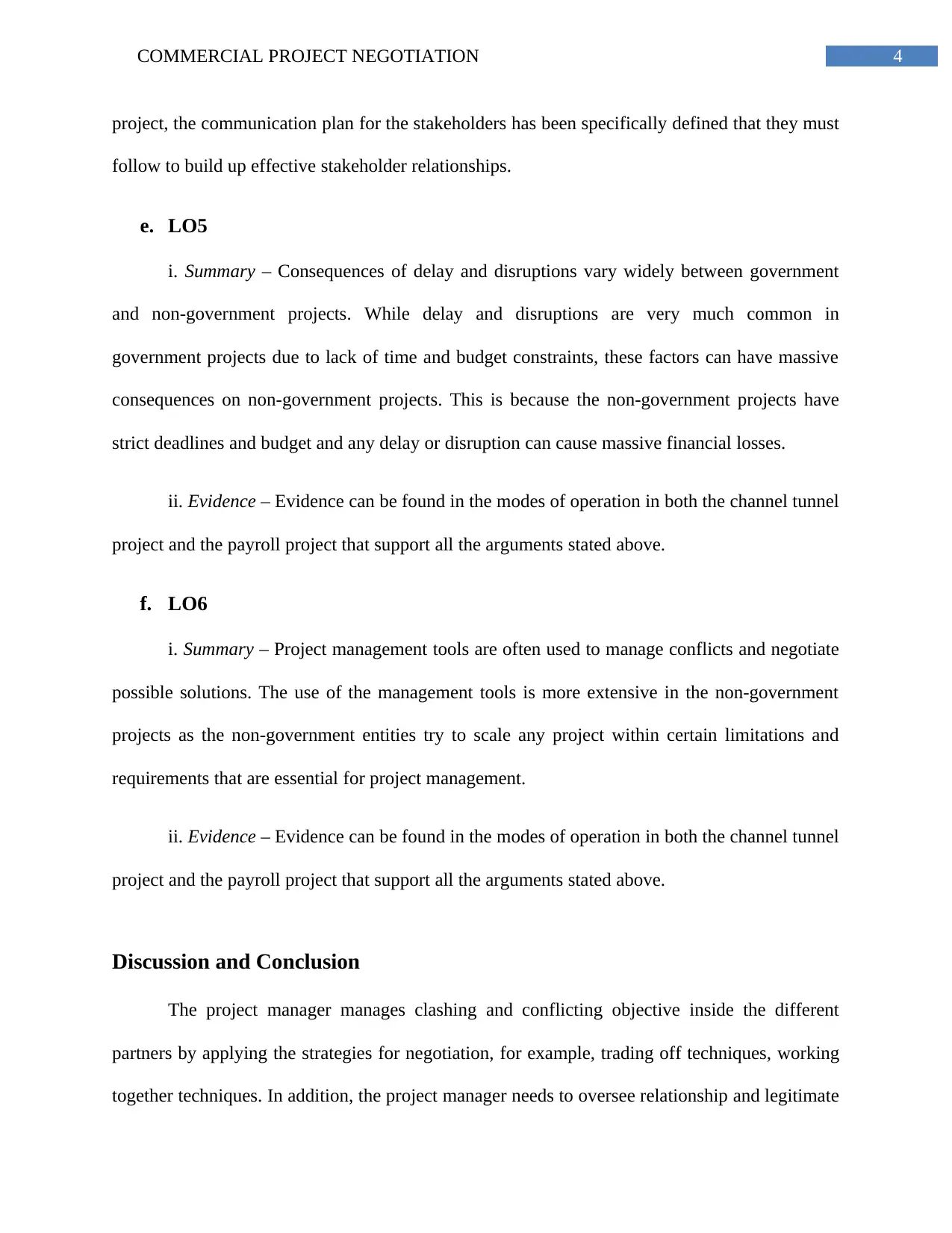
4COMMERCIAL PROJECT NEGOTIATION
project, the communication plan for the stakeholders has been specifically defined that they must
follow to build up effective stakeholder relationships.
e. LO5
i. Summary – Consequences of delay and disruptions vary widely between government
and non-government projects. While delay and disruptions are very much common in
government projects due to lack of time and budget constraints, these factors can have massive
consequences on non-government projects. This is because the non-government projects have
strict deadlines and budget and any delay or disruption can cause massive financial losses.
ii. Evidence – Evidence can be found in the modes of operation in both the channel tunnel
project and the payroll project that support all the arguments stated above.
f. LO6
i. Summary – Project management tools are often used to manage conflicts and negotiate
possible solutions. The use of the management tools is more extensive in the non-government
projects as the non-government entities try to scale any project within certain limitations and
requirements that are essential for project management.
ii. Evidence – Evidence can be found in the modes of operation in both the channel tunnel
project and the payroll project that support all the arguments stated above.
Discussion and Conclusion
The project manager manages clashing and conflicting objective inside the different
partners by applying the strategies for negotiation, for example, trading off techniques, working
together techniques. In addition, the project manager needs to oversee relationship and legitimate
project, the communication plan for the stakeholders has been specifically defined that they must
follow to build up effective stakeholder relationships.
e. LO5
i. Summary – Consequences of delay and disruptions vary widely between government
and non-government projects. While delay and disruptions are very much common in
government projects due to lack of time and budget constraints, these factors can have massive
consequences on non-government projects. This is because the non-government projects have
strict deadlines and budget and any delay or disruption can cause massive financial losses.
ii. Evidence – Evidence can be found in the modes of operation in both the channel tunnel
project and the payroll project that support all the arguments stated above.
f. LO6
i. Summary – Project management tools are often used to manage conflicts and negotiate
possible solutions. The use of the management tools is more extensive in the non-government
projects as the non-government entities try to scale any project within certain limitations and
requirements that are essential for project management.
ii. Evidence – Evidence can be found in the modes of operation in both the channel tunnel
project and the payroll project that support all the arguments stated above.
Discussion and Conclusion
The project manager manages clashing and conflicting objective inside the different
partners by applying the strategies for negotiation, for example, trading off techniques, working
together techniques. In addition, the project manager needs to oversee relationship and legitimate
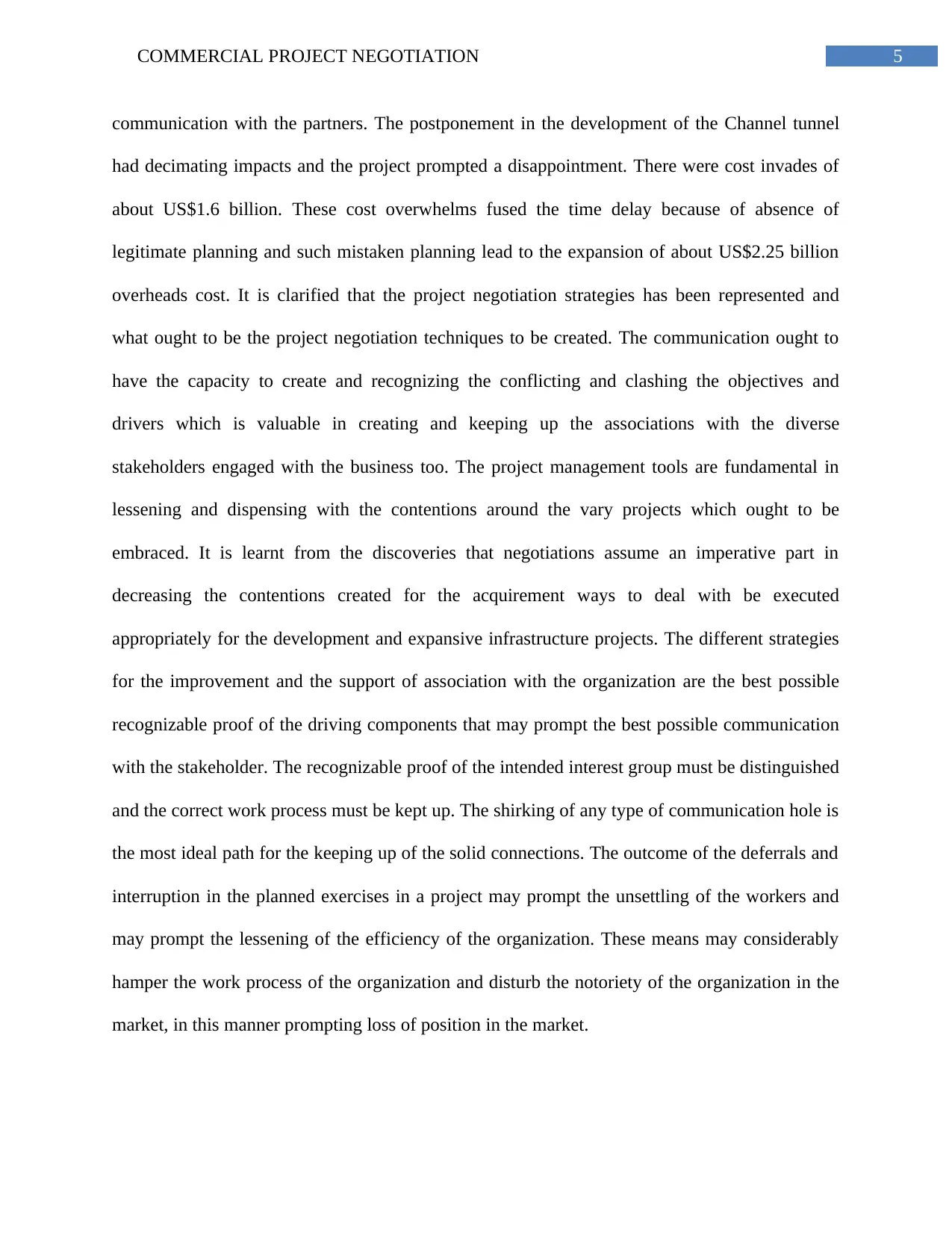
5COMMERCIAL PROJECT NEGOTIATION
communication with the partners. The postponement in the development of the Channel tunnel
had decimating impacts and the project prompted a disappointment. There were cost invades of
about US$1.6 billion. These cost overwhelms fused the time delay because of absence of
legitimate planning and such mistaken planning lead to the expansion of about US$2.25 billion
overheads cost. It is clarified that the project negotiation strategies has been represented and
what ought to be the project negotiation techniques to be created. The communication ought to
have the capacity to create and recognizing the conflicting and clashing the objectives and
drivers which is valuable in creating and keeping up the associations with the diverse
stakeholders engaged with the business too. The project management tools are fundamental in
lessening and dispensing with the contentions around the vary projects which ought to be
embraced. It is learnt from the discoveries that negotiations assume an imperative part in
decreasing the contentions created for the acquirement ways to deal with be executed
appropriately for the development and expansive infrastructure projects. The different strategies
for the improvement and the support of association with the organization are the best possible
recognizable proof of the driving components that may prompt the best possible communication
with the stakeholder. The recognizable proof of the intended interest group must be distinguished
and the correct work process must be kept up. The shirking of any type of communication hole is
the most ideal path for the keeping up of the solid connections. The outcome of the deferrals and
interruption in the planned exercises in a project may prompt the unsettling of the workers and
may prompt the lessening of the efficiency of the organization. These means may considerably
hamper the work process of the organization and disturb the notoriety of the organization in the
market, in this manner prompting loss of position in the market.
communication with the partners. The postponement in the development of the Channel tunnel
had decimating impacts and the project prompted a disappointment. There were cost invades of
about US$1.6 billion. These cost overwhelms fused the time delay because of absence of
legitimate planning and such mistaken planning lead to the expansion of about US$2.25 billion
overheads cost. It is clarified that the project negotiation strategies has been represented and
what ought to be the project negotiation techniques to be created. The communication ought to
have the capacity to create and recognizing the conflicting and clashing the objectives and
drivers which is valuable in creating and keeping up the associations with the diverse
stakeholders engaged with the business too. The project management tools are fundamental in
lessening and dispensing with the contentions around the vary projects which ought to be
embraced. It is learnt from the discoveries that negotiations assume an imperative part in
decreasing the contentions created for the acquirement ways to deal with be executed
appropriately for the development and expansive infrastructure projects. The different strategies
for the improvement and the support of association with the organization are the best possible
recognizable proof of the driving components that may prompt the best possible communication
with the stakeholder. The recognizable proof of the intended interest group must be distinguished
and the correct work process must be kept up. The shirking of any type of communication hole is
the most ideal path for the keeping up of the solid connections. The outcome of the deferrals and
interruption in the planned exercises in a project may prompt the unsettling of the workers and
may prompt the lessening of the efficiency of the organization. These means may considerably
hamper the work process of the organization and disturb the notoriety of the organization in the
market, in this manner prompting loss of position in the market.
⊘ This is a preview!⊘
Do you want full access?
Subscribe today to unlock all pages.

Trusted by 1+ million students worldwide
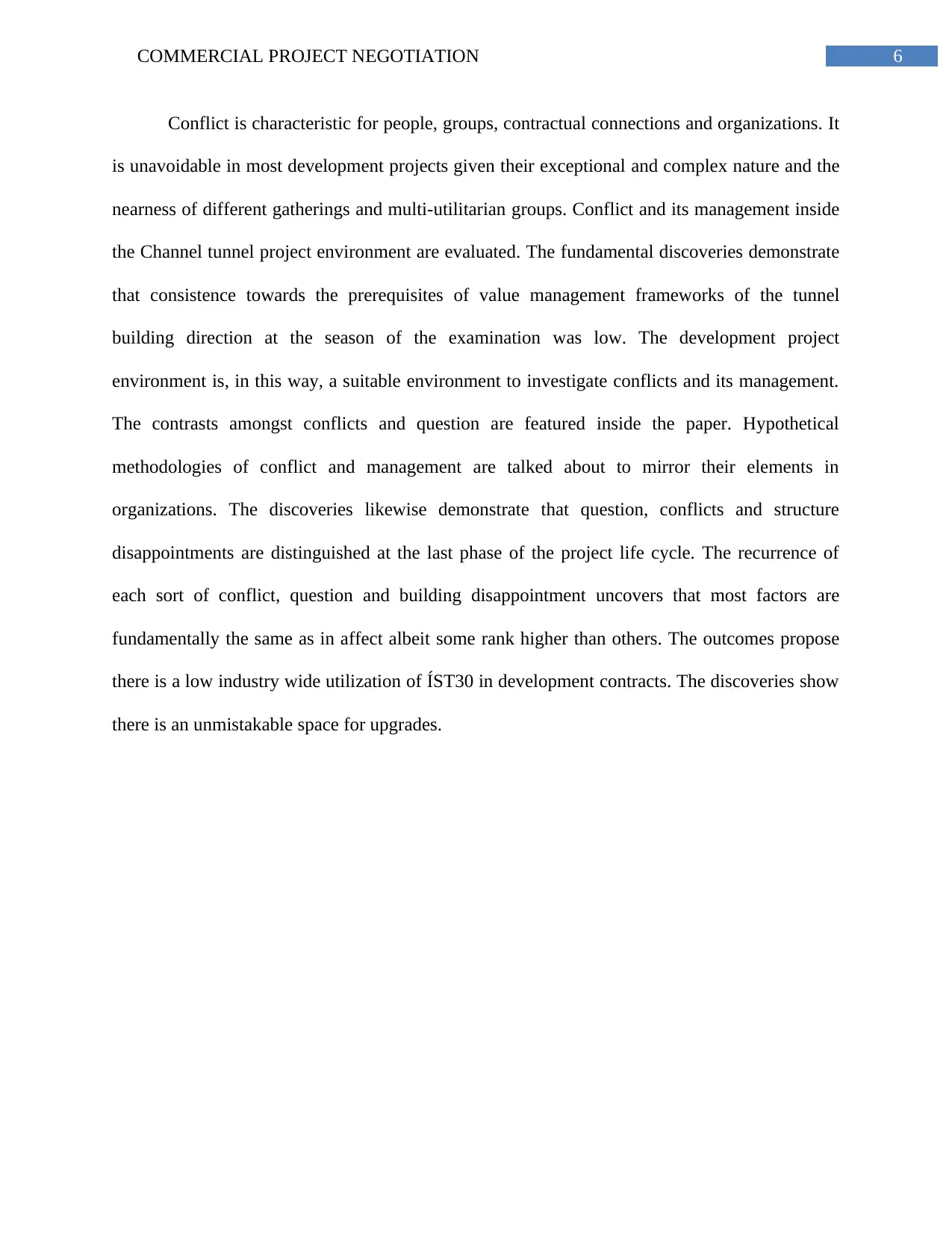
6COMMERCIAL PROJECT NEGOTIATION
Conflict is characteristic for people, groups, contractual connections and organizations. It
is unavoidable in most development projects given their exceptional and complex nature and the
nearness of different gatherings and multi-utilitarian groups. Conflict and its management inside
the Channel tunnel project environment are evaluated. The fundamental discoveries demonstrate
that consistence towards the prerequisites of value management frameworks of the tunnel
building direction at the season of the examination was low. The development project
environment is, in this way, a suitable environment to investigate conflicts and its management.
The contrasts amongst conflicts and question are featured inside the paper. Hypothetical
methodologies of conflict and management are talked about to mirror their elements in
organizations. The discoveries likewise demonstrate that question, conflicts and structure
disappointments are distinguished at the last phase of the project life cycle. The recurrence of
each sort of conflict, question and building disappointment uncovers that most factors are
fundamentally the same as in affect albeit some rank higher than others. The outcomes propose
there is a low industry wide utilization of ÍST30 in development contracts. The discoveries show
there is an unmistakable space for upgrades.
Conflict is characteristic for people, groups, contractual connections and organizations. It
is unavoidable in most development projects given their exceptional and complex nature and the
nearness of different gatherings and multi-utilitarian groups. Conflict and its management inside
the Channel tunnel project environment are evaluated. The fundamental discoveries demonstrate
that consistence towards the prerequisites of value management frameworks of the tunnel
building direction at the season of the examination was low. The development project
environment is, in this way, a suitable environment to investigate conflicts and its management.
The contrasts amongst conflicts and question are featured inside the paper. Hypothetical
methodologies of conflict and management are talked about to mirror their elements in
organizations. The discoveries likewise demonstrate that question, conflicts and structure
disappointments are distinguished at the last phase of the project life cycle. The recurrence of
each sort of conflict, question and building disappointment uncovers that most factors are
fundamentally the same as in affect albeit some rank higher than others. The outcomes propose
there is a low industry wide utilization of ÍST30 in development contracts. The discoveries show
there is an unmistakable space for upgrades.
Paraphrase This Document
Need a fresh take? Get an instant paraphrase of this document with our AI Paraphraser
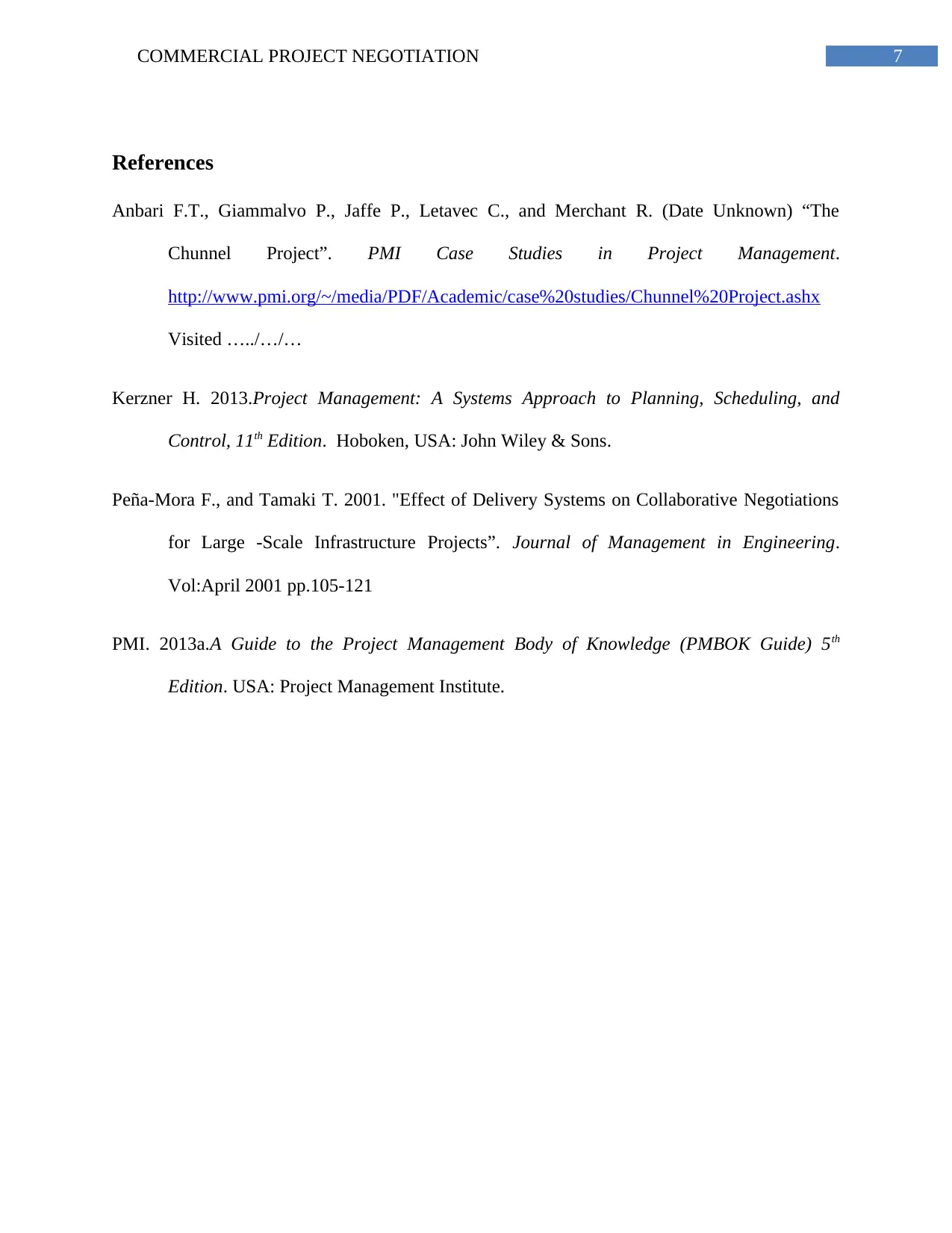
7COMMERCIAL PROJECT NEGOTIATION
References
Anbari F.T., Giammalvo P., Jaffe P., Letavec C., and Merchant R. (Date Unknown) “The
Chunnel Project”. PMI Case Studies in Project Management.
http://www.pmi.org/~/media/PDF/Academic/case%20studies/Chunnel%20Project.ashx
Visited …../…/…
Kerzner H. 2013.Project Management: A Systems Approach to Planning, Scheduling, and
Control, 11th Edition. Hoboken, USA: John Wiley & Sons.
Peña-Mora F., and Tamaki T. 2001. "Effect of Delivery Systems on Collaborative Negotiations
for Large -Scale Infrastructure Projects”. Journal of Management in Engineering.
Vol:April 2001 pp.105-121
PMI. 2013a.A Guide to the Project Management Body of Knowledge (PMBOK Guide) 5th
Edition. USA: Project Management Institute.
References
Anbari F.T., Giammalvo P., Jaffe P., Letavec C., and Merchant R. (Date Unknown) “The
Chunnel Project”. PMI Case Studies in Project Management.
http://www.pmi.org/~/media/PDF/Academic/case%20studies/Chunnel%20Project.ashx
Visited …../…/…
Kerzner H. 2013.Project Management: A Systems Approach to Planning, Scheduling, and
Control, 11th Edition. Hoboken, USA: John Wiley & Sons.
Peña-Mora F., and Tamaki T. 2001. "Effect of Delivery Systems on Collaborative Negotiations
for Large -Scale Infrastructure Projects”. Journal of Management in Engineering.
Vol:April 2001 pp.105-121
PMI. 2013a.A Guide to the Project Management Body of Knowledge (PMBOK Guide) 5th
Edition. USA: Project Management Institute.
1 out of 8
Related Documents
Your All-in-One AI-Powered Toolkit for Academic Success.
+13062052269
info@desklib.com
Available 24*7 on WhatsApp / Email
![[object Object]](/_next/static/media/star-bottom.7253800d.svg)
Unlock your academic potential
Copyright © 2020–2025 A2Z Services. All Rights Reserved. Developed and managed by ZUCOL.

